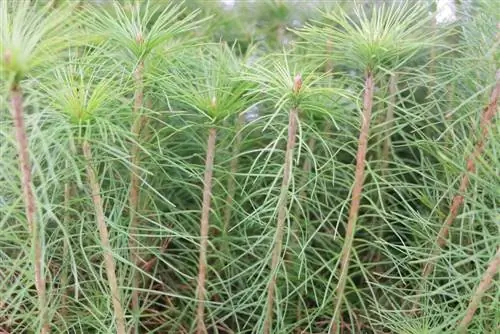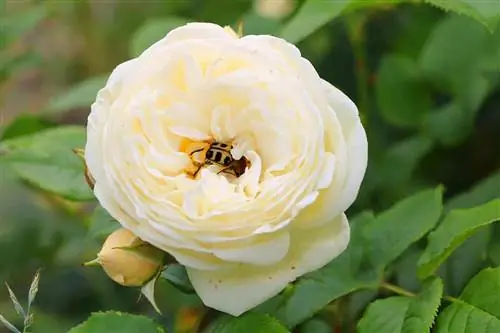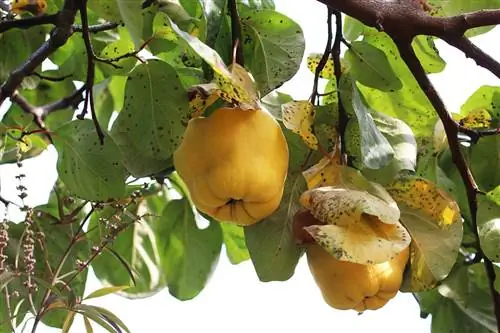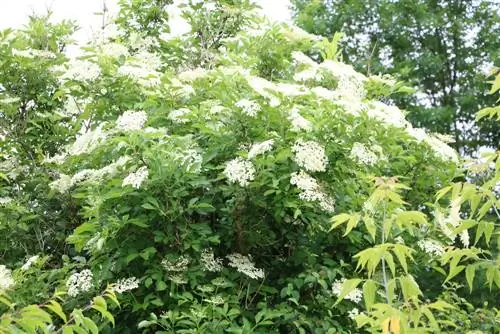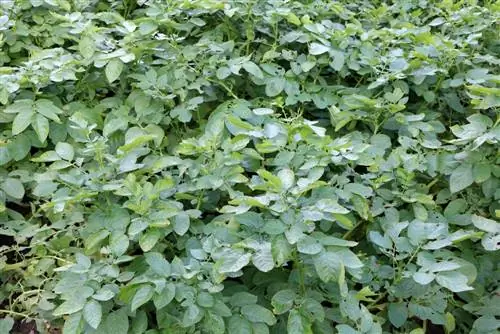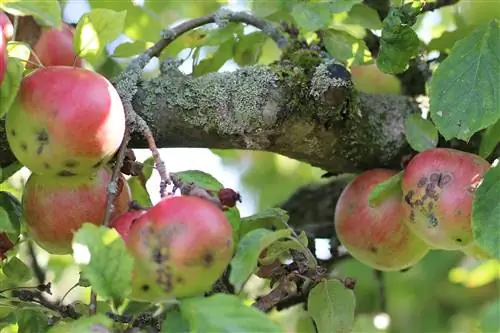- Author admin [email protected].
- Public 2023-12-17 03:39.
- Last modified 2025-01-24 12:45.
The following is a brief overview of the (supposed) pine pests:
Native and introduced pine guests
There are a lot of animals that feel comfortable in the pine trees, and unfortunately new pests are increasingly being transported from their natural range to new regions. Such introductions are increasing rapidly worldwide due to the globalization of trade, which can lead to economic and ecological damage when forest trees are infested. So it's not wrong if you're interested in the small animals on your pine tree.
- The pine visitors include, for example, various longhorn beetles, of which the Pogonocherus fasciculatus, the pine twig longhorn beetle, and the Cortodera femorata, the pine top deep-eyed longhorn beetle, are “responsible” for the pine trees.
- There are also various bark beetles that have multiplied en masse in our area since the 1990s. The fact that these beetles can become a serious threat is particularly evident in the Canadian province of British Columbia, where it is expected that 80 percent of the local pine trees will be destroyed by a bark beetle called the Mountain Pine Beetle by 2013.
- In addition, some butterflies like to colonize pine trees, such as the pine owl, the pine moth and the pine hawkmoth. Among the wasp species, the pine bush sawfly and the pine tree sawfly are particularly interested in pine trees. Other pine visitors include the pine jewel beetle and various pine weevils.
Dangerous pine pests
While the butterflies, wasps and beetles also contain beneficial insects and even some particularly protected species, the nuns (Lyrnantria monacha L.), which are also inclined towards pine trees, are no longer among the microorganisms that could be neglected as harmless.
The nun tends to multiply heavily and tends to spread rapidly, especially as a result of warm, dry summers. In particular, it eats spruce trees completely bare, which are often irreversibly damaged by this removal of needles. Pine trees can usually recover from a one-time nun infestation. However, repeated heavy feeding is also fatal for them. This is why the forest authorities are fighting nuns on a large scale if a critical egg number has only been determined in parts of a population. For this purpose, various plant protection products are used that are not available for private use; More environmentally friendly (biological or biotechnical) control methods are currently not apparent. In May 2012 z. For example, in the Altmarkkreis Salzwedel (Saxony-Anh alt on the border with Lower Saxony), around 4,400 hectares of forest are sprayed from the air with pesticides to prevent the spread of the nuns.
The pine wood nematode is even more dangerous, but it doesn't seem to have reached us yet. Various plant protection services and forestry administrations are also increasing their monitoring of imported wood depots from which the nematodes could be transmitted to domestic stocks by longhorn beetles. If this dangerous pine pest finds its way to us one day, it would e.g. For example, you will probably find favorable conditions in Brandenburg, where around 80 percent of the forests consist of pine trees.
Nevertheless, the last thing you should do if you see small animals on your jaws is to quickly reach for a lethal injection. Because first of all, e.g. For example, it has not yet been said whether these are pests; perhaps beneficial insects protected by the Federal Endangered Species Act have also taken a liking to your pine tree. So there are a whole series of other measures to take beforehand:
Inquire about the local pest population and analyze the location
If there are animals in your jaws, the first sensible reaction would be a quick call to the local plant protection office. This way you can quickly find out whether there is an alarm about imported or native pests in your region. If this is not the case, you should first carry out a detailed analysis of the condition of the trees and the changes that have occurred recently: You should check the soil around your trees, the moisture supply and the nutrient supply and also inquire whether weed killers have been used in the area that your trees are suffering from. Most pests prefer to attack weakened and damaged trees.
Dealing with pine pests yourself: Better only with expert advice
If everything is fine in the area, it is still advisable to get expert support first if you want to take action against the infestation of a pine tree. There are several good reasons for this:
- In many cases it is not necessary for you to take any action at all. If your jaws e.g. For example, if spider sawflies visit you in the spring, a he althy tree should be able to handle it without your intervention.
- Before spraying pesticides, you should first make sure that you are allowed to use them. Against the larvae of the web sawfly, for example: For example, a product with the active ingredients pyrethrum and rapeseed oil (Spruzit) is approved, but not for pine trees in the home and allotment garden area. In addition, you would have to hit each caterpillar directly when spraying - it would probably be quicker to collect them anyway.
In general, the plant protection products intended for home and allotment gardens are only approved for certain plants and certain pests. They may also only be used at certain times: There are e.g. B. Products that are approved for moths or peepers, but only in a certain larval stage (L1 to L2), only in the field at the start of the infestation orThe first symptoms or harmful organisms become visible and only for very specific moths or peepers such as the frost moth. Other agents may be used against butterfly caterpillars, but not the owl species among them. Or they are approved for ornamental trees, but not for ornamental conifers such as pines in the garden.
Because among the visitors to your pine tree there could be several species that are protected by the Federal Species Protection Act: The beetles (Coleoptera), for example, include: B. with a few exceptions, the jewel beetles (Buprestidae), the longhorn beetles (Cerambycidae), the oil beetles (genus Meloe), the schröter (Lucanidae) and the ground beetles are under special legal protection.
That's why a precise diagnosis is always necessary before using any plant protection products, which, in addition to the precise identification of the pest, can also bring positive results such as a complete all-clear: This is a yellowing of the needles inside orThe lower area of the branches is quite normal in pine trees, so if you consult a professional you could not only receive advice on how to combat it, but you could also find out that your pine tree is simply fine with it.

